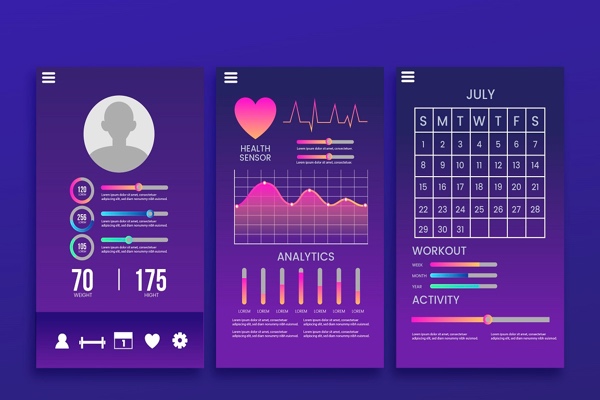If you want to get developed your own fitness app or looking for a top fitness app development company, you need to follow some steps. Going from a fitness and health app idea to Android and iOS fitness application development becomes easy for you after reading this post. Dividing the procedure of building your app into different steps makes your fitness app development journey easy. Let’s take a look at some significant steps that will assist you to create your own fitness app.
Step 1. Choose platform or research market:
If you want to get fitness mobile app development, initially, you need to know your target audience and the devices your consumers are probable to use. Your users may like to run your fitness app on a tablet or check some stats on their wrist. User experience for gym exercises and home workouts can be drastically different. Here are some questions that you need to consider at this step:
- What is my USP?
- What mobile platforms should I cover?
- How exactly do I envision individuals utilizing this application?
Step 2. Prototype and user-test:
Prototyping is usually when you want to bring in an agency with relevant user experience or user interface expertise, while market research is something you can do on your own. Your app idea is converted into the first meaningful form prototype. Here a question will arise in your mind about the prototype; what is it? Basically, an interactive representation of your application is a prototype. While developing a fitness app, our first step is to prepare a low-fidelity version of the design and then work on a high-fidelity prototype.
Step 3. Select the tech stack:
You will be ready for the next step with the prototype verified. Why is it essential to spend time selecting the right tech stack for your project? There are many reasons that are discussed below:
- Your selection will impact the budget for health and fitness app development.
- Some limitations on your mobile product’s capabilities can be imposed by a tech stack.
In addition, here are some technologies that can be used to develop a fitness app:
Native apps:
Native apps are mostly developed with the assistance of Swift and Java/Kotlin; however, they can take more time to be developed.
Cross platform:
Kotlin Multiplatform, Flutter, React Native, and a number of other cross-platform application frameworks answer the question of how to build a health and fitness app for Android and iOS simultaneously, reusing the code. Consequently, you get a more tangible budget and a rapid time-to-market.
A progressive web app or shortly PWA may be an ideal variant when you need to adjust the present application to mobile. Or when you want to start small and don`t need to connect to any platform hardware or any external. This technique is one of the best choices to create a fitness app.
No-code mobile application builders:
You need to choose no-code tools like Appy Pie in order to build your own fitness app. You can use that at your own risk.
Step 4. Build and test, rinse and repeat:
Finally, we reached the coding part: preparing sprints with the task, reporting to you, reviewing the progress, and sharing feedback. You need to understand that; personal trainer app development may seem like a black box. Presently, we are trying to make the development process as transparent as possible. And constantly keeping you in the loop on its progress through Slack, email, and regular video meetings. In addition to this, the quality part of this step is quality assurance, and it takes place after each interaction to ensure new features work well. The questions that we have to answer contain:
What things do we need to do to preserve the scope and, at the same time cut the development cost?
- Resume off the self-components for barcode scanning, food data, charts, and other features you envision.
- You can go with react native or PWA
What do we need to integrate with it?
- Sensor, Good Fit, Apple Health, and Samsung Health are all good places to start
- Mobile solutions like Fitbit, Endmondo, etc. with relevant user data.
Steps for application testing:
- Peer to peer coding review
- Manual testing with unit tests
- Automated testing with a tool like Crashlytics and Sentry.io
Whether you need to worry about HIPAA compliance:
- As we know, fitness applications typically don`t transmit PHI therefore, no HIPAA compliance is needed.
- How to make fitness app development more secure?
- Adding bio authentication like TouchID or Facetime is enough for its security. Moreover, social logins should also suffice most of the time.
Step 5: Release and Maintain
Now in the final step, we are ready to release the app to the mobile stores. If you want to grow your products, you will need to do:
- From a built-in mobile analytics tool, you can check its usage
- Monitor customer reviews and in-app feedback with the help of email or a built-in customer feedback tool
- Don`t forget to update the solution with new features and adjust existing ones based on user feedback
This quest never ends, your audience keeps growing, and the gym workout tracker keeps developing.
Wrapping up
After reading this informative guide on the development of fitness apps, you may come to know all about it. Hopefully, the information shared through this post regarding fitness mobile app development will be more beneficial for you according to your search. Furthermore, you can ask your questions or send your suggestions in the below comment section box. Thank you for reaching out.





.png)




.png)


.png)


1 Comments
Hello there, I frequently read your writings. Your sense of humour is clever; keep it up! Thank you for sharing this interesting and useful information. If you're seeking for the best healthcare development with flutter, then visit Appic Softwares. I liked reading this blog post.
ReplyDelete